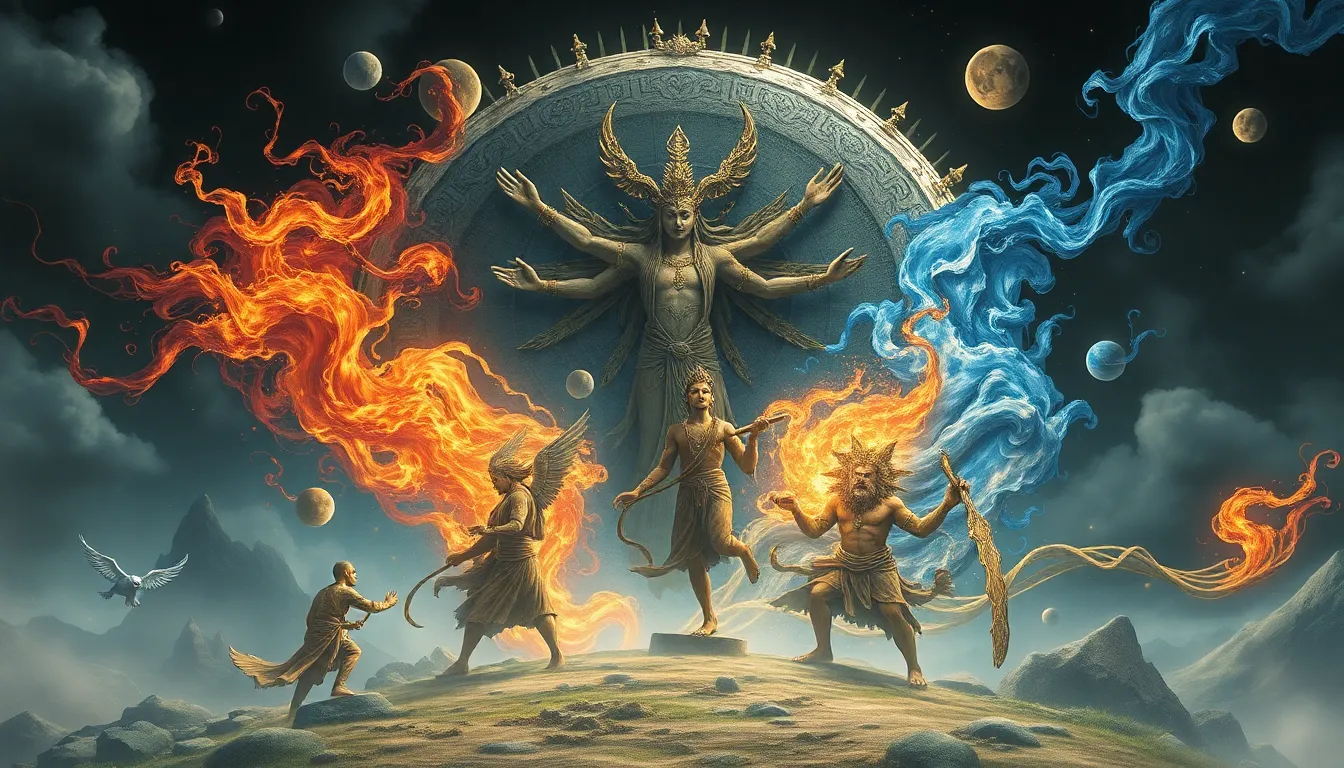Ancient Deities and Their Role in the Cycle of Seasons
I. Introduction
The significance of deities in ancient cultures cannot be overstated. These divine figures often represented various aspects of life, nature, and the cosmos, and their influence was deeply woven into the fabric of daily existence. In many societies, deities were seen as the guardians and controllers of natural phenomena, including the changing seasons.
This article explores the interplay between ancient deities and the seasonal cycles, revealing how these mythological figures embodied the essence of spring, summer, autumn, and winter. By understanding these connections, we can gain insights into how ancient peoples viewed their world and the natural rhythms that governed their lives.
II. The Concept of Seasons in Ancient Cultures
The seasons are typically divided into four distinct periods: Spring, Summer, Autumn, and Winter. Each season carries its own unique characteristics and significance, often linked to agricultural cycles and the fertility of the earth.
In ancient societies, the agricultural calendar was paramount. The success of crops and the survival of communities depended on the ability to predict and respond to seasonal changes. Thus, rituals and ceremonies were often closely tied to these cycles, celebrating the renewal of life in spring, the abundance of summer, the harvest in autumn, and the restfulness of winter.
II.A. Definition of the seasons: Spring, Summer, Autumn, Winter
- Spring: Marked by rebirth and renewal, symbolizing new life and fertility.
- Summer: Characterized by growth and abundance, associated with warmth and light.
- Autumn: The time for harvesting, reflecting themes of gratitude and preparation for the coming cold.
- Winter: Represents rest and reflection, a period of dormancy and introspection.
II.B. The agricultural calendar and its importance to ancient societies
The agricultural calendar was crucial for ancient civilizations, dictating when to plant and harvest crops. This cyclical understanding of time reinforced the connection between deities, agriculture, and the seasons, leading to various festivals and rituals that sought divine favor for bountiful harvests.
II.C. How seasonal changes influenced daily life and rituals
Seasonal changes profoundly influenced daily life, from food availability to clothing choices. Rituals were often performed at specific times of the year to ensure harmony with the environment, reflecting a deep respect for nature and its cycles.
III. Spring: The Season of Rebirth
Spring is often viewed as the season of rebirth and renewal, a time when the earth awakens from its winter slumber. Various deities are associated with this transformative period.
III.A. Deities associated with spring (e.g., Persephone, Eostre)
- Persephone: In Greek mythology, she represents the cycle of life and death, as her return from the underworld heralds spring.
- Eostre: A Germanic goddess associated with spring and fertility, her name is the root of the modern festival of Easter.
III.B. Myths surrounding rebirth and fertility
Many myths center on themes of death and rebirth, illustrating the cyclical nature of life. The story of Persephone, for example, symbolizes the changing seasons and the eternal return of life each spring.
III.C. Rituals and festivals celebrating spring (e.g., Easter, Vernal Equinox)
Spring festivals often include rituals to celebrate fertility and the renewal of life. Notable examples include:
- Easter: A Christian celebration of resurrection, intertwined with ancient spring celebrations.
- Vernal Equinox: Marked by various cultures as a time of balance and renewal.
IV. Summer: The Season of Growth and Abundance
Summer is the season of growth, characterized by warmth, light, and abundance. During this time, many deities are celebrated for their association with fertility and harvest.
IV.A. Deities of summer (e.g., Apollo, Demeter)
- Apollo: The Greek god of light, music, and prophecy, often associated with the sun and summer.
- Demeter: The goddess of agriculture, her connection to summer reflects the peak of crop growth.
IV.B. Symbolism of light and growth in summer mythology
Summer myths often emphasize the importance of light and growth. The sun is a powerful symbol of life and fertility, making summer a celebration of abundance.
IV.C. Agricultural festivals and summer celebrations (e.g., Solstice, Harvest Festivals)
Summer is rich with festivals, such as:
- Summer Solstice: Celebrated in many cultures as the longest day of the year, symbolizing the peak of sunlight.
- Harvest Festivals: Celebrations of the bounty of the earth, expressing gratitude for the food produced.
V. Autumn: The Season of Harvest and Transition
As summer gives way to autumn, the focus shifts to themes of harvest, transition, and gratitude. Various deities embody this seasonal change.
V.A. Autumn deities and their significance (e.g., Ceres, Bacchus)
- Ceres: The Roman goddess of agriculture, representing the bounty of the harvest.
- Bacchus: The god of wine, associated with harvest festivities and the joys of abundance.
V.B. Themes of gratitude and preparation for winter
Autumn is a time for reflection and gratitude, as communities prepare for the cold months ahead. This season emphasizes the importance of reaping what has been sown.
V.C. Autumn festivals and rituals (e.g., Samhain, Thanksgiving)
Autumn is marked by several significant festivals, including:
- Samhain: An ancient Celtic festival marking the end of the harvest season and the beginning of winter.
- Thanksgiving: A modern celebration of gratitude for the harvest, rooted in ancient traditions.
VI. Winter: The Season of Rest and Reflection
Winter signifies a time of rest, introspection, and renewal. Deities associated with this season often embody themes of death and rebirth.
VI.A. Deities associated with winter (e.g., Odin, Hades)
- Odin: In Norse mythology, he represents wisdom and the mysteries of death.
- Hades: The Greek god of the underworld, his realm symbolizes the resting phase of nature.
VI.B. Myths of death and renewal in winter time
Winter myths often explore themes of death and renewal, emphasizing the need for rest before the cycle of rebirth begins again in spring.
VI.C. Winter celebrations and traditions (e.g., Yule, Winter Solstice)
Winter is celebrated with various traditions, such as:
- Yule: A festival celebrating the winter solstice, marking the return of longer days.
- Winter Solstice: Celebrated in many cultures, it symbolizes hope and the promise of new beginnings.
VII. Comparative Analysis of Deities Across Cultures
Examining the deities associated with the seasons reveals both similarities and differences across cultures. While many societies have deities that represent similar seasonal themes, their interpretations can vary widely.
VII.A. Similarities and differences in deities related to the seasons
Common themes often emerge, such as fertility in spring or abundance in summer, yet each culture imbues their deities with unique attributes and narratives.
VII.B. Cross-cultural myths and their interpretations of seasonal changes
Many cultures share myths that reflect the universal experience of seasonal changes, yet they interpret these transformations through their own cultural lenses, leading to rich and varied mythologies.
VII.C.
https://www.youtube.com/watch?v=ag_zGd50dMg



